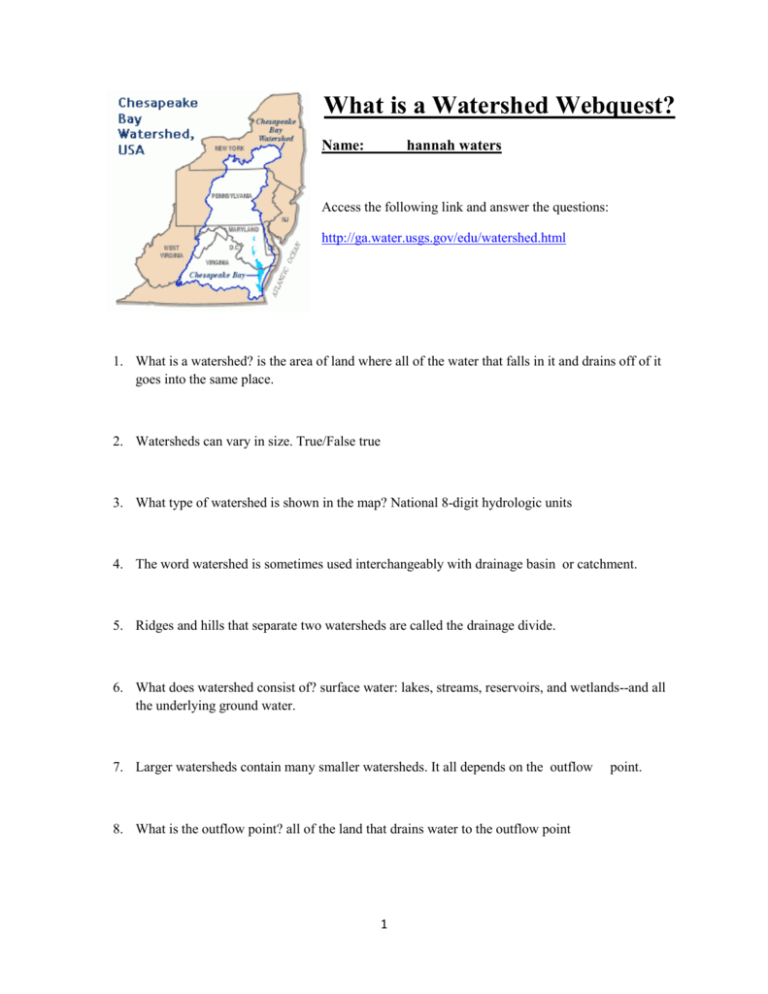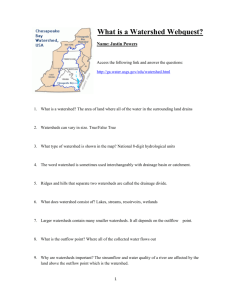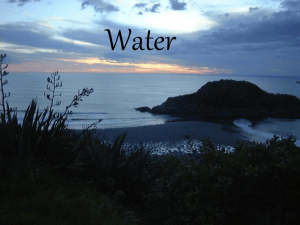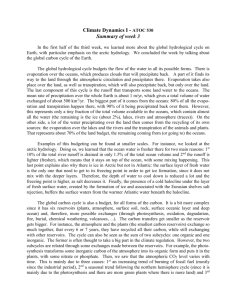What is a Watershed Webquest
advertisement

What is a Watershed Webquest? Name: hannah waters Access the following link and answer the questions: http://ga.water.usgs.gov/edu/watershed.html 1. What is a watershed? is the area of land where all of the water that falls in it and drains off of it goes into the same place. 2. Watersheds can vary in size. True/False true 3. What type of watershed is shown in the map? National 8-digit hydrologic units 4. The word watershed is sometimes used interchangeably with drainage basin or catchment. 5. Ridges and hills that separate two watersheds are called the drainage divide. 6. What does watershed consist of? surface water: lakes, streams, reservoirs, and wetlands--and all the underlying ground water. 7. Larger watersheds contain many smaller watersheds. It all depends on the outflow 8. What is the outflow point? all of the land that drains water to the outflow point 1 point. 9. Why are watersheds important? because the streamflow and the water quality of a river are affected by things, human-induced or not, happening in the land area "above" the river-outflow point A Watershed is a precipitation collector: 1. Name 6 factors that determine how much of the streamflow will flow by the monitoring site? pricipitation, water used by people, infliteration, transpiration, storage, and evaporation. 2. What is the greatest factor controlling streamflow? pricipitation 3. The amount of water that will infiltrate (soak in over time) depends on which four characteristics? soil characteristics, soil saturation, land cover, and slope of the land. 4. Water from rainfall returns to the atmosphere largely through evaporation. 5. The root systems of plants absorb water from the surrounding soil in various amounts through the process of transpiration. 6. storage store water and increase the amount of water that evaporates and infiltrates. The Water Cycle: Evaporation Access the following link and answer the questions http://ga.water.usgs.gov/edu/watercycleevaporation.html 1. What is evaporation? the process by which water changes from a liquid to a gas or vapor. 2. Why does evaporation occur? because of heat 3. What is the opposite of evaporation? condinsation 2 4. How does evaporation drive the water cycle? Evaporation from the oceans is the primary mechanism supporting the surface-to-atmosphere portion of the water cycle. 5. What are the two main products obtained from the evaporation of water? salt and minerals. 6. Explain how evaporative cooling works. In climates where the humidity is low and the temperatures are hot, an evaporator cooler, such as a "swamp cooler" can lower the air temperature by 20 degrees F., while it increases humidity. The Water Cycle: Transpiration: Access the following link and answer the questions http://ga.water.usgs.gov/edu/watercycletranspiration.html 1. What is transpiration? the process by which moisture is carried through plants from roots to small pores on the underside of leaves, where it changes to vapor and is released to the atmosphere. 2. How much water do plants transpire during the growing season? During a growing season,they will transpire many times more water than its own weight. 3. What are the fiveatmospheric factors that affect transpiration? tempeture, wind and air movement, relative humitiy, soil-moisture avaliability,and type of plant. 4. Draw a diagram that shows how the water table can dip where plant roots can access it during the growing season. The Water Cycle: Freshwater Storage:Access the following link and answer the questions http://ga.water.usgs.gov/edu/watercyclefreshstorage.html 1. What part of the water cycle that is essential to all life on Earth? freshwater existing on the land surface. 3 2. What is the definition of freshwater? water containing less than 1,000 milligrams per liter of dissolved solids, most often salt. 3. Earth's surface water bodies are generally thought of as renewable resources. 4. Inflows to these water bodies will be from pricipitation, overland runoff, groundwater seepage, and tributary inflows. 5. Outflows from lakes and rivers include eveaporation, movement of water into groundwater, and withdrawals by people. 6. The glaciers and snowpacks of surface water changes over time and space. 7. glaceriers are what made the Great Lakes not only "great, " but also such a huge storehouse of freshwater. 8. Water on the land surface really does sustain life. 9. Freshwater represents only about 3% percent of all water on Earth and freshwater lakes and swamps account for a mere 0.29% percent of the Earth's freshwater. 10. 20% percent of all fresh surface water is in one lake, Lake Baikal in Asia. 11. Another 20%percent (about 5,500 cubic miles (about 23,000 cubic kilometers)) is stored in the Great Lakes. 12. Rivers hold only about 0.006% percent of total freshwater reserves. 4 13. People have built systems, such as large reservoirs and small water towars 14. to store water for when they need it. These systems allow people to live in places where nature doesn't always supply enough water or where water is not available at the time of year it is needed. 5








